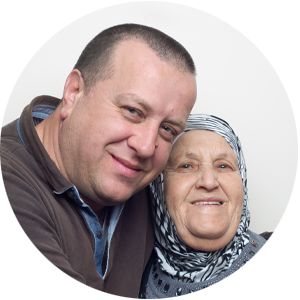Eye conditions we treat
Eye conditions
We make it easy to get the help you need
Diabetic Retinopathy
If you have diabetes, you are at a higher risk of eye diseases which can lead to severe vision loss and sometimes even blindness.
Diabetic eye diseases include:
- Cataracts
- Glaucoma
- Diabetic retinopathy
Diabetic retinopathy can affect you if you have Type I and Type II diabetes, by damaging the blood vessels in your retina.
Symptoms
There are no common symptoms present during the early stages of diabetic retinopathy. If you experience blurred vision or “floating” spots, contact your ophthalmologist as soon as possible.
There are four stages to diabetic retinopathy:
1. Mild non-proliferative retinopathy
Minor swelling occurs in small regions in the tiny blood vessels of the retina.
2. Moderate non-proliferative retinopathy
The blood vessels in the retina are blocked.
3. Severe non-proliferative retinopathy
The blockage of the blood vessels causes malnourishment to the retina, which causes the retina to send signals to the body to create new blood vessels.
4. Proliferative retinopathy
The newly formed blood vessels develop along the surface of the retina and are very fragile. Their fragility can cause them to leak, which can lead to severe vision loss and even blindness. This stage can also cause macular edema, which can lead to vision loss.
Preventative measures
If you have diabetes, you can help prevent the development of diabetic retinopathy by carefully managing your blood sugar level and blood pressure. If you are at the final stage of diabetic retinopathy (proliferative retinopathy), laser treatments are available to help shrink the fragile blood vessels. This can ultimately preserve the rest of your sight.
Age-related macular degeneration
Age-related macular degeneration (AMD) is a breakdown of the macula. The macula is located in the center of the retina and provides the sharp central vision that is necessary for reading, driving and other essential tasks.
There are two forms of AMD: wet and dry. Dry AMD is more common and occurs when the macula deteriorates, causing blurry vision.
Wet AMD is more damaging and can lead to severe vision loss.
Macular holes
Macular holes are tears or cysts that can develop in the macula (a small spot in the retina, or back inner part of the eye). The macula is where fine focusing occurs.
Macular holes are most often related to the ageing process and are most common in people over 60.
Symptoms
You may notice a macular hole when there is a sudden decrease in vision in one eye.
Treatment
Occasionally, macular holes may resolve without treatment. However, we recommend you see an ophthalmologist immediately if you notice a sudden loss of vision in one eye so that they can determine if treatment is necessary. Early diagnosis is essential to help prevent permanent vision loss.
The most common treatment for macular holes is a surgery called vitrectomy. Vitrectomy is a process that removes the vitreous gel to prevent it from pulling on the retina. Next, we insert a mixture of air and gas into where the vitreous once was, putting pressure on the macular hole, allowing it to heal.
This treatment requires a lengthy recovery period to ensure lasting results.
Retinal Detachment
Retinal detachment is a severe condition which can cause severe or even permanent vision loss. It occurs when the retina becomes separated from the underlying supportive tissues, which prevents the retina from functioning properly. No pain is associated with retinal detachment.
Some common symptoms include:
- Spots
- Floaters
- Flashes of light
- Poor vision or a shadow appearance across the top of the eye
What are floaters?
Floaters are small specks that move in and out of your field of vision. They may be more noticeable when looking at a plain background. Floaters are tiny clumps of cells inside the vitreous humour (the clear fluid that fills the inside of the eye) that can be different shapes.
If you notice any of the above symptoms or believe you have a detached retina, it is vitally important to seek ophthalmic care immediately to prevent permanent vision loss.
Discover your options to get your eyes back in top shape
Call us and we’ll help you take the steps you need to repair your eyes
Other eye conditions
We make it easy to get the help you need
Allergies
If you suffer from seasonal eye allergies or are experiencing unusual eye pain, tearing, itching or swelling, you should consult your ophthalmologist.
Treatment
Many different types of medical treatments for eye allergies are available by prescription. Your ophthalmologist may prescribe eye drops to treat certain eye conditions, infections or diseases.
Before using eye drops, you should inform your ophthalmologist if you are taking any other prescription or nonprescription medications. You should also inform them of any allergies that you have.
Cataract
According to the American Academy of Ophthalmology, more than half of all Americans will develop cataracts by age 80. A cataract is a clouding of the lens in the eye, which can cause one’s vision to become blurry. It is common with age and can occur in one or both eyes. The clouding usually occurs slowly but can happen quickly, especially after trauma to the eye.
Symptoms
While cataracts are not painful, they may cause the following symptoms:
- Blurry vision
- Glare while driving or reading
- Dull colors
- Frequent changes in your glasses prescription
- Double vision in one eye
Treatment
New advances and techniques have made cataract surgery one of the most successful and life-improving surgical procedures performed. We offer the latest procedures available to help remove cataracts and restore your vision, including the placement of intraocular lenses. Most cataract surgeries are performed on an outpatient basis, and more than 95% of surgeries improve vision.
Chalazion
A chalazion is a lump that appears in the upper eyelid as a result of an inflamed oil-producing sweat gland. When this gland becomes blocked, it can rupture and cause pain and redness. It can also cause the eyelid to swell as large as an eighth of an inch.
Treatment
Use warm compresses for 10-15 minutes, 2-4 times a day to help reduce swelling. If after 3-4 days the swelling hasn’t subsided, contact your ophthalmologist.
You should contact your ophthalmologist immediately if you experience any of the following symptoms:
- Headache
- Fever
- Blurred or decreased vision
- Drainage
- Extensive swelling and redness
- Both eyes and eyelids are swollen
Dry eye
Tears are essential for the eyes for several reasons. Not only do tears act as a lubricant, they also clean the eye by washing out dust, debris and foreign objects. Tears also have antibacterial and neutralizing properties that counteract microorganisms that take residence on the eye’s surface.
When tear production is insufficient, it can create many problems for the eyes. Not only are dry eyes uncomfortable, but they are also more prone to injury and infection.
For incidental cases of dry eyes, over-the-counter eye lubricants are all that is required to ease the discomfort. However, when the body does not produce enough tears, or when the tears are drained or evaporated too quickly, the eye is not protected. This is a condition known as dry eye syndrome.
Treatment
Depending on the cause and extent of dry eye syndrome, it may or may not be able to be completely cured. Even when not cured, however, the symptoms can be managed.
Restasis eye drops
One of the treatments for dry eye syndrome is Restasis eye drops. These are a prescription artificial tear formula that contains materials that not only lubricate and comfort the eye but also encourage the eye to produce more tears.
Lacrimal plug
Another possible treatment is the installation of lacrimal plugs, also called punctal plugs. The plugs are inserted into the tear ducts, to stop tears from draining off the surface of the eye too quickly.
Surgery
In more extreme cases, we may have to close the tear ducts surgically.
Preventative measures
If dry eyes are a result of your environment – for example dry or dusty conditions at work – it may be helpful to wear sunglasses or to use a humidifier.
Nutritional insufficiencies can also be to blame for dry eyes, in which case we advise you to take dietary supplements or to drink more water.
Glaucoma
Glaucoma is a common eye disorder that is, in fact, not one but an entire group of disorders. It is a disorder that damages the optic nerve, which serves to send the images from the eye to the brain.
High intraocular pressure is a risk factor for glaucoma; however, it is not the only cause.
Symptoms
The early stages of glaucoma are undetectable, and experts estimate that only half of the people who currently have glaucoma even realize that they are affected.
Treatment
While there is no cure for glaucoma, many medications and procedures exist that can help to slow the disease or stop it altogether. However, like so many eye-related disorders, early diagnosis is essential. Because the early stages of glaucoma have no noticeable symptoms, we recommend regular eye exams for everyone, even if you have no eye-related symptoms or problems.
Strabismus / lazy eye
Strabismus, also sometimes called “lazy-eyed”, “cross-eyed” or “wall-eyed,” is a condition that occurs when a person cannot align both of their eyes on a single object at the same time under normal circumstances. According to experts, it is estimated that roughly 5% of all children have some degree of strabismus.
Symptoms
Movement of the affected eyes can either occur all the time or under certain conditions like high stress or illness. Children with strabismus will occasionally experience double vision as a result of the conflicting signals from their eyes. Eventually, their brains learn to disregard one of the eyes, but this does not affect the actual condition of the eye.
Treatment
Early treatment is strongly advised for children with strabismus because it is not a condition that children “grow out of”. Some conventional treatments for strabismus include optical devices, vision and muscle therapy, and, as a last resort, surgery.
Vision problems
We make it easy to get the help you need
Astigmatism
A refractive error is when the shape of your eye does not bend light correctly, causing blurred vision.
Astigmatism is an irregular curvature on the cornea (front surface of the eye) which causes a person’s vision to be blurred at all distances.
Symptoms
If you experience blurred vision, difficulty reading or crossing of the eyes, it may mean you have a refractive disorder. Contact your ophthalmologist for a complete eye exam.
Treatment
Refractive disorders are commonly treated with corrective lenses, whether it be eyeglasses or contact lenses. However, some refractive disorders require refractive surgery.
Keratoconus
Keratoconus is an extreme form of astigmatism in which the clear tissue on the front of your eye (the cornea) thins and bulges outward into a cone shape. Changing the shape of the cornea brings light rays out of focus, which reduces your clarity of vision.
Symptoms
If you experience difficulty driving, watching TV, recognising faces across a room, or struggle with outdoor mobility, it may mean you have a corneal disorder. Contact your ophthalmologist for a complete eye exam.
Treatment
Mild corneal disorders are commonly treated with corrective lenses, whether it be eyeglasses or contact lenses. Alternative treatments for more severe cases include corneal cross-linking or corneal transplant.
Farsightedness / hyperopia
A refractive error is when the shape of your eye does not bend light correctly, causing blurred vision.
Hyperopia, also known as farsightedness, is when close objects appear blurry. Hyperopia is most common in children. It can improve as a person ages.
Symptoms
If you experience blurred vision, difficulty reading or crossing of the eyes, it may mean you have a refractive disorder. Contact your ophthalmologist for a complete eye exam.
Treatment
Refractive disorders are commonly treated with corrective lenses, whether it be eyeglasses or contact lenses. However, some refractive disorders require refractive surgery.
Nearsightedness / myopia
A refractive error is when the shape of your eye does not bend light correctly, causing blurred vision.
Myopia, also known as nearsightedness, is when distant objects appear blurry. The condition is inherited and usually discovered in childhood. As a person ages, myopia can progress, requiring a stronger prescription to correct vision.
Symptoms
If you experience blurred vision, difficulty reading or crossing of the eyes, it may mean you have a refractive disorder. Contact your ophthalmologist for a complete eye exam.
Treatment
Refractive disorders are commonly treated with corrective lenses, whether it be eyeglasses or contact lenses. However, some refractive disorders require refractive surgery.
Presbyopia
A refractive error is when the shape of your eye does not bend light correctly, causing blurred vision.
Presbyopia is the aging of the lens in the eye, which can make reading more difficult. This usually occurs in people over the age of 40.
Symptoms
If you experience blurred vision, difficulty reading or crossing of the eyes, it may mean you have a refractive disorder. Contact your ophthalmologist for a complete eye exam.
Treatment
Refractive disorders are commonly treated with corrective lenses, whether it be eyeglasses or contact lenses. However, some refractive disorders require refractive surgery.
How to get help
These 3 easy steps allow you to stop worrying about your eyes
STEP 1:
Call us to get an appointment
Give us a call at (718) 630-1010 and we’ll answer the questions you have so that we can recommend the best next step.
STEP 2:
Visit us
Whatever the issue, we’ll provide you with the exceptional care that your most precious sense deserves.
STEP 3:
Get the help you need
Whether it’s a quick intervention or a long-term treatment plan, we’ll guide you with compassion, every step of the way.
Discover your options to get your eyes back in top shape
Call us and we’ll help you take the steps you need to repair your eyes
Affiliations and memberships
We are proud to be associated with these professional organisations
A comprehensive Brooklyn and ManhattanEye Clinic
Looking for treatment for a particular eye problem? Find more information below:
What our patients say
★★★★★
We’ve been getting 5-star reviews from savvy Brooklynites and New Yorkers for over 20 years


Dr.Khosrof is one of the most knowledgeable doctors in his field. My family and I have been his patients for years and he has never failed to provide us tip top service and always does what’s safest for us and our eyes…


I want to talk about Dr. Samer, he is extremely professional and kind and he has the latest equipment and great staff. He’s very caring about his patients and takes the time to explain.


Dr. Khosrof is an outstanding physician and surgeon with a great bedside manner. As a fellow Ophthalmologist, I have always been impressed by his talent.


Dr. Khosrof improved my eye sight from 20/400 to 20/80. I had previously see 2 other retina specialists and 1 optometrist and none of them were able to help me. He’s terrific!
About the expert
Dr. Samer Khosrof | Ophthalmologist
Dr. Samer Khosrof is a top eye surgeon in New York City with over 25 years of experience treating complex eye conditions such as diabetic retinopathy and age-related eye conditions.
His extensive experience enables him to stay on top of the latest treatments available. He believes in the efficacy of medical technology and has the expertise to deploy the newest diagnostic and treatment techniques to treat his patients with 100% confidence.
When you become a New York Eye & Retina Clinic patient; you’re a Samer Khosrof patient first. This means he sees you before your surgery, he performs your surgery, and he provides your aftercare. In the end, you’re his patient, and he takes that responsibility very seriously.
































